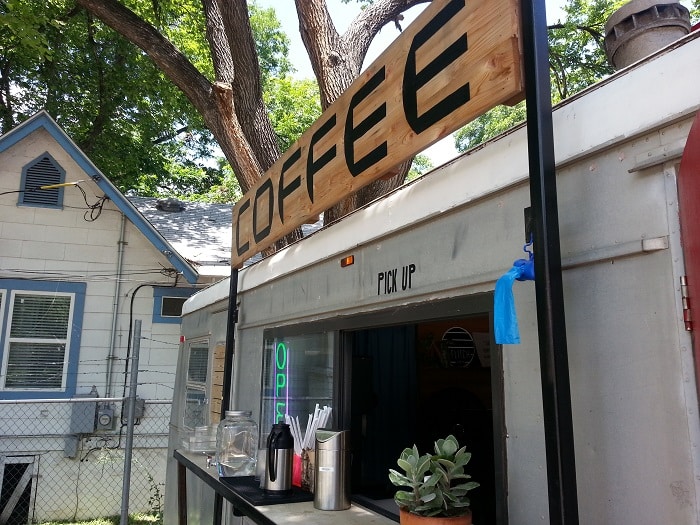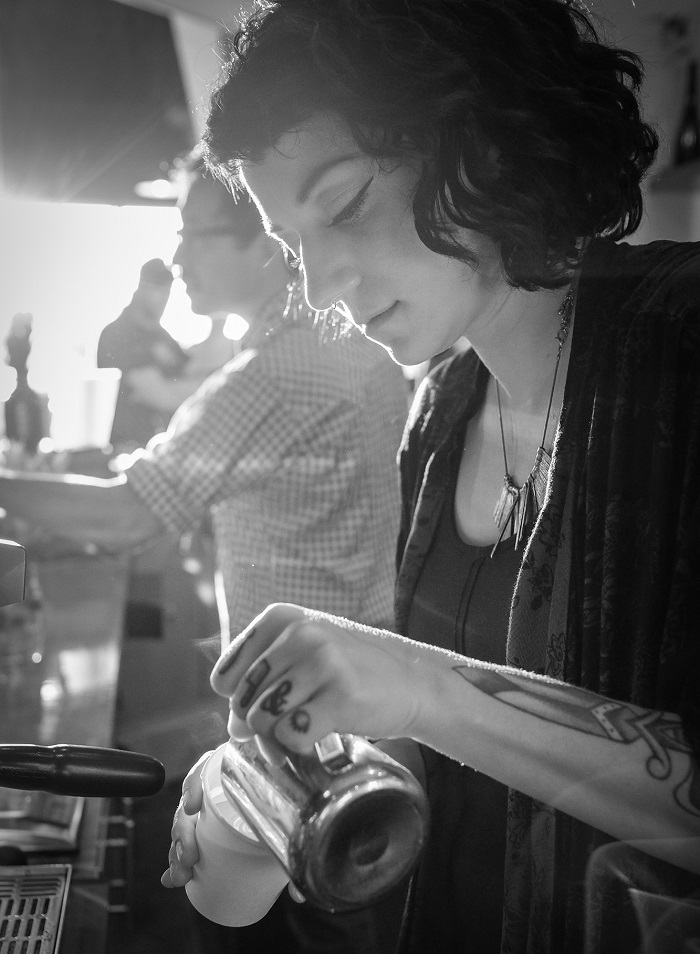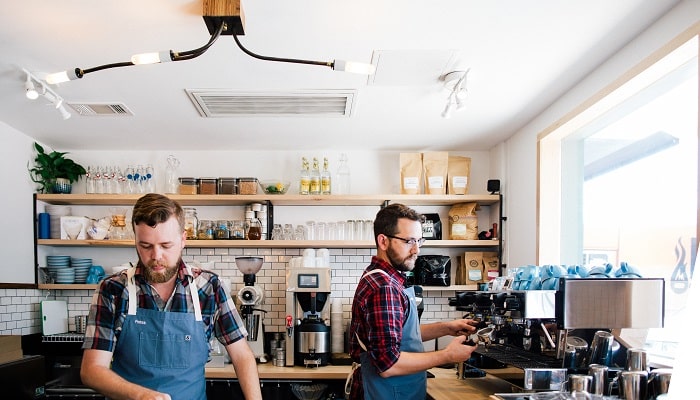
Flitch Coffee trailer in East Austin
Guest article by Natalie Parra-Novosad
I’ll go out of my way every morning just to get an espresso or cappuccino at one of my favorite cafes, even if it means being a little late for work. I’ll never enjoy a coffee from Starbuck’s or a gas station again.
Sometimes I wallow in guilt over the fact that I’m willing to fork over a good chunk of my salary to satisfy my craving for exceptional coffee, often multiple times a day. But after getting to know the baristas at four of my favorite Austin coffee shops, I feel less guilty about my habit.
Meet the faces behind the flavor.
Houndstooth Coffee: Paul Henry

Paul Henry, Director of Austin Relationships at Houndstooth Coffee
There’s a lot that goes into making the perfect cup of espresso, from farming to brewing. As stated by Houndstooth Coffee’s Paul Henry, “The question in people’s minds shouldn’t be ‘Why is coffee so expensive,’ but rather ‘Why is it so cheap?’”
Henry has been working at Houndstooth Coffee since they opened in 2010. He proudly says, “Houndstooth was the first café in Austin to offer multiple espressos.” When I asked him about quality control and how they maintain flavor consistency, he said they dial in several times throughout the day–a process that involves setting the weight for each dose, setting the size of the grind and determining how long to pull the shot. Their machine also weighs every shot that comes out of the machine. He says, “Baristas have a significant responsibility to the roaster, which is to make sure the coffee tastes right.”
“The roaster not only roasts coffee beans, but picks the combination of beans for blends as well.” Not unlike a winemaker, the roaster determines what types of beans will create the best flavor profile when blended. When asked about his favorite coffee for espresso, Henry said single-origin coffees are popular, but great blends get taken for granted. He likes Tweed’s Timepiece and Counter Culture’s Hologram for making espresso. These tend to have a great flavor profile, and flavors like milk chocolate, caramel, blueberry and even cherry cola tend to be found in them.
Because Houndstooth is so focused on tasting, they offer a “two for” deal to anyone who wants to try their espressos side by side.
4200 N Lamar Blvd. and 401 Congress Ave. – Website
Epoch Coffee: Raechel Hurd

Raechel Hurd, Coffee Educator/Head Barista at Epoch Coffee (Credit: Ariele Baragona)
Raechel Hurd is the coffee educator at Epoch Coffee’s West Anderson Lane location and has an obvious love for coffee and everything that goes into its creation. When I spoke to Hurd about tasting espresso, she said her guidelines are to “focus on the aroma, body and flavor.”
Similar to wine, different types of espressos have different thicknesses. She recommends going on a coffee tour. “Consecutively try espressos at several different coffee places and you’ll start to notice the different flavors.” She says this is part of how they train new baristas at Epoch Coffee.
A great tool for tasting coffee is the Specialty Coffee Association of America’s flavor wheel, which Epoch displays on the wall at their West Anderson location. The wheel helps people identify the multitude of flavors that can be picked up in a cup of coffee. It contains flavors on a spectrum from woody and nutty to herb-like.
When I asked Hurd how the barista’s role affects the flavor of espresso most, she said the size of the grind has the biggest impact, as well as how long it takes to pull a shot. She says, “A shot that is under-pulled will have a salty, briny taste, while a shot that is over-pulled will have more of a bitter taste.”

Specialty Coffee Association of America’s flavor wheel
I also asked about the differences between the espressos at Epoch’s North Loop location compared to their West Anderson Lane location, as I tend to prefer the espresso at the latter. Hurd said the espresso at North Loop is made with Rude Boy and it’s on the dark and heavy side, while West Anderson Lane uses Ritual, which is light, bright and juicy. Each location caters heavily to the preferences of their neighborhood clientele.
One of Hurd’s personal favorites for making espresso is Hologram from Counter Culture.
221 W. North Loop and 2700 W. Anderson Lane – Website
Flitch Coffee: Erica Foster

Erica Foster, entrepreneur and barista at Flitch Coffee
After successfully launching her project on Kickstarter, Erica Foster opened Flitch Coffee next to Hatch Workshop in 2015. Flitch is housed by a renovated Spartan trailer, with several tables surrounding it outdoors under the oak trees. (Although the café’s official address is Tillery Street, the entrance is on Holton Street.)
After sitting down to discuss the ins and outs of espresso and all the factors that contribute to its taste, Foster said, “The barista’s role is essential because they can bring out the best in a not-so-great coffee or make a wonderful coffee taste bad.” Like Raechel Hurd at Epoch Coffee, Foster says the duration of pulling a shot and the grind affect the flavor most.
All that hard work that went into biology, farming, trade and roasting of the beans can be utterly ruined no matter how good the bean is if the barista doesn’t do the job right. Foster appreciates a single origin espresso for its clean and focused flavor profile and loves Kenyan coffee. One of her personal favorites is Kickapoo coffee.
641 Tillery St. – Website
Fleet Coffee: Lorenzo Perkins

Lorenzo Perkins (right), Co-founder/Coffee Manager at Fleet Coffee
With 15 years of experience, Lorenzo Perkins is an Austin coffee industry veteran. He previously worked for Cuvee Coffee and Caffé Medici and won the South Central Region at both the U.S. Barista Championship and at the U.S. Brewers Cup–twice each.
Perkins just opened Fleet Coffee in March on Webberville Road across from The Dog and Duck Pub, and fans in the neighborhood are eager to take advantage of his talent and expertise. The small, 365-square-foot café was still hopping half an hour before close on a Tuesday when I dropped in.
When asked about testing and quality control for espresso, Perkins said “While we do all the testing and weighing of the espresso, a good barista should be able to look at it and know when something is off, whether it’s the thickness of the stream coming out of the machine, the color of the crema or the distribution of coffee in the portafilter.”
He reminds me of a chef who intuitively knows when something is done just by the smell and look of it. He also remarked that, “cleanliness is extremely important.” Espresso machines get dirty quickly, and a dirty machine can drastically alter the flavor of the final product. For espresso, Perkins appreciates a well-executed blend, ideally something that mixes Latin American beans with East African beans.
If you are just getting into espresso, he recommends trying it in the form of a small americano, no more than six ounces. That way, you can still pick up on all the flavors, but it won’t be as overpowering.
2427 Webberville Road – Website
Unlike sommeliers, baristas not only play the part of suggesting the right coffee for you, but they play an enormous role in how the final product tastes. Next time you have a well-executed cup of espresso, take a moment to reflect on the entire process from beginning to end–the farming to the roasting, shipping and preparation, and all labor that goes into it. Then, sit back and breathe in the aroma from your steamy, creamy cup of espresso. Sip and enjoy!
@theAustinot wants to know:
Who’s your favorite barista in Austin?
An inherent food-lover, Natalie Parra-Novosad grew up in her father’s BBQ joint in small-town Texas. After living in various cities, she’s back in Austin and loves writing about the local food and wine scene.
- Best Austin Restaurants With a View – 8 Most Scenic Places to Eat - October 8, 2022
- 7 Best Austin Restaurants With a View: Most Scenic Places to Eat - October 21, 2021
- DipDipDip Tatsu-ya Is Making Austin Go Wild Over Shabu Shabu - January 27, 2020

Great read, Natalie!
hello natalie parra,i like your articles the way of your start your days with coffee shop and am also start and spend my days with coffee at every morning .